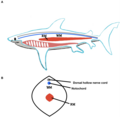Welcome to the shark portal

Sharks are a group of elasmobranch fish characterized by a cartilaginous skeleton, five to seven gill slits on the sides of the head, and pectoral fins that are not fused to the head. Modern sharks are classified within the clade Selachimorpha (or Selachii) and are the sister group to the Batoidea (rays and kin). Some sources extend the term "shark" as an informal category including extinct members of Chondrichthyes (cartilaginous fish) with a shark-like morphology, such as hybodonts. Shark-like chondrichthyans such as Cladoselache and Doliodus first appeared in the Devonian Period (419–359 million years), though some fossilized chondrichthyan-like scales are as old as the Late Ordovician (458–444 million years ago). The earliest confirmed modern sharks (selachimorphs) are known from the Early Jurassic around 200 million years ago, with the oldest known member being Agaleus, though records of true sharks may extend back as far as the Permian.
Sharks range in size from the small dwarf lanternshark (Etmopterus perryi), a deep sea species that is only 17 centimetres (6.7 in) in length, to the whale shark (Rhincodon typus), the largest fish in the world, which reaches approximately 12 metres (40 ft) in length. They are found in all seas and are common to depths up to 2,000 metres (6,600 ft). They generally do not live in freshwater, although there are a few known exceptions, such as the bull shark and the river sharks, which can be found in both seawater and freshwater, and the Ganges shark, which lives only in freshwater. Sharks have a covering of dermal denticles that protects their skin from damage and parasites in addition to improving their fluid dynamics. They have numerous sets of replaceable teeth.
Several species are apex predators, which are organisms that are at the top of their food chain. Select examples include the bull shark, tiger shark, great white shark, mako sharks, thresher sharks, and hammerhead sharks. (Full article...)
Selected article -
Epaulette sharks have nocturnal habits and frequent shallow water on coral reefs or in tidal pools. This shark has evolved to cope with the severe nighttime oxygen depletion (hypoxia) in isolated tidal pools by increasing the blood supply to its brain and selectively shutting down non-essential neural functions. It is capable of surviving complete anoxia for an hour without ill effects, and at a much higher temperature than most other hypoxia-tolerant animals. Rather than swim, epaulette sharks "walk" by wriggling their bodies and pushing with their paired fins. This species feeds on a wide range of small benthic invertebrates and bony fishes. Epaulette sharks are oviparous, with females depositing pairs of egg capsules around every 14 days from August to December. Due to their hardiness and small size, epaulette sharks are popular with both public and home aquaria. The World Conservation Union has assessed this species as of Least Concern, as outside of the small aquarium trade it is of little interest to fisheries.
Did you know (auto-generated)

- ... that the ampullae of Lorenzini enable sharks to sense electric fields?
- ... that "the Hurricane Shark is real"?
- ... that since 2018, IKEA's stuffed toy shark Blåhaj has become a popular Internet meme and an icon of the online transgender community?
- ... that Hixxy and Sharkey created a schism in the UK rave music scene in 1995?
- ... that Alexis Sharkey's last Instagram post before her murder documented her travels to Tulum, Mexico?
- ... that Timo Meier became the first player in San Jose Sharks franchise history to score five goals in one game when he was 25?
Categories
Related portals
WikiProjects
Selected picture -

More Did you know? -
- ... that the whitefin dogfish has light-producing organs on its upper eyelids?
- ... that the spinner shark is named for the spinning leaps it makes out of the water as part of its feeding strategy?
- ...that John Singleton Copley's painting, Watson and the Shark, was based on a real-life shark attack that occurred in Havana, Cuba in 1749?
- ... that, like the related cookiecutter shark, the kitefin shark sometimes feeds by taking bites out of animals larger than itself?
- ... that the first successful artificial insemination of a shark was performed in the cloudy catshark?
General images
Topics
For additional lists of marine life-related featured articles and good articles see:
Wikimedia
The following Wikimedia Foundation sister projects provide more on this subject:
-
Commons
Free media repository -
Wikibooks
Free textbooks and manuals -
Wikidata
Free knowledge base -
Wikinews
Free-content news -
Wikiquote
Collection of quotations -
Wikisource
Free-content library -
Wikispecies
Directory of species -
Wikiversity
Free learning tools -
Wiktionary
Dictionary and thesaurus














































